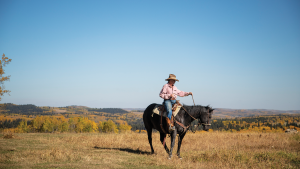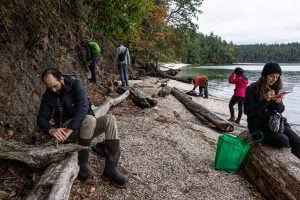Mosses are funny things. Centuries of growth can be snuffed with a simple boot swiped across a rock. Meanwhile, as scientists at the University of Alberta recently discovered, mosses buried beneath a hunk of ice dozens of metres thick for 400 years can come out surprisingly intact.
As the Teardrop Glacier on Ellesmere Island, Nunavut, retreats, it is exposing clues to an ecosystem from before the Little Ice Age (from about 1550 to 1850). Previous studies of newly exhumed plant life on Baffin and Ellesmere islands have indicated that all remaining vegetation was dead. But when Catherine La Farge, a biologist at the University of Alberta, trekked north with her team to check out the remains, they found patches of green sprigs among the blackened debris. The mosses had been exposed for about two years, and they’d already begun showing signs of coming back to life. The researchers collected and radiocarbon-dated samples. After returning to Edmonton, they ground up the samples, and with some simple care (potting soil and water over the course of a year), the team saw four different taxa begin to grow.
Bryophytes, a catch-all term for land-based non-vascular plants such as mosses, have a unique stem-cell-like ability to reprogram cells to serve other purposes. They can shut down during desiccation and revive when conditions are more favourable. The plants’ “remarkable biological resilience” hints that the often-overlooked bryophytes may play a much more significant role in recolonizing Arctic ecosystems. That means that when a receding glacier (or other force) leaves the landscape bald, these mosses could be among the first on the scene to rebuild.
“In a world of diminishing biological diversity,” the researchers state in their newly published study, “preservation of subglacial bryophytes serves as an unrecognized genetic reservoir.” The study was published in the Proceedings of the National Academy of Sciences journal.
These bryophytes aren’t the oldest plants to be regenerated after a long thaw. A specimen, which lived more than 30,000 years ago during the Pleistocene epoch, was taken from Siberian permafrost and cultured, but the process was far more complicated than the relatively low-maintenance bryophytes from Ellesmere Island.
It’s this structural simplicity that may make the bryophytes such an amenable test subject for biological development in space.
Ice in the Canadian Arctic Archipelago has been gradually melting over the past century, with the speed accelerating in recent years. The Teardrop Glacier has receded three to four metres a year since 2004, exposing an ever-widening glimpse of the past as it goes.





